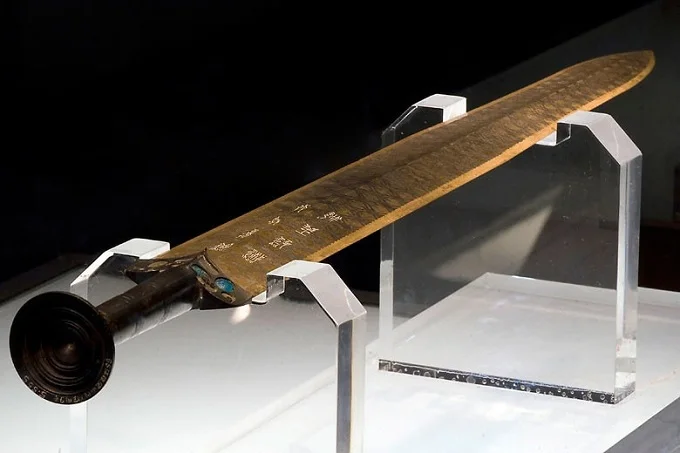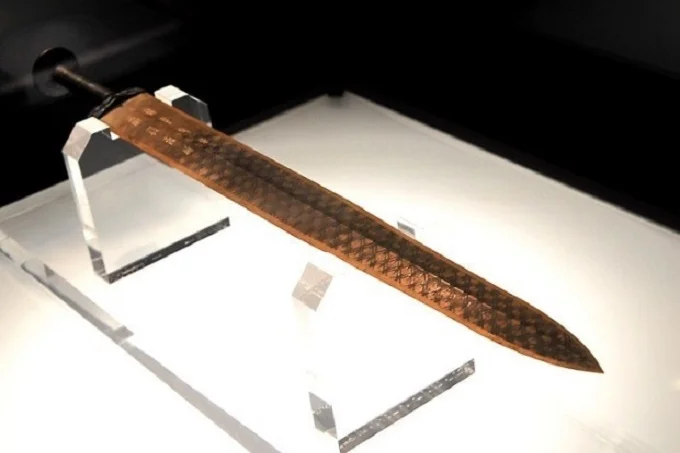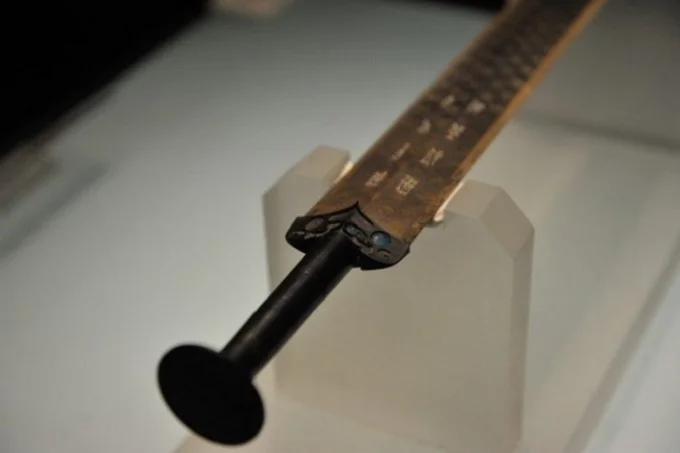How old is the sword of Goujian and what mystery does it keep?

Ancient China is known as the birthplace of many inventions – gunpowder, paper, porcelain. But Chinese blacksmiths were no less talented. A 2,500-year-old bronze Goujian sword found in the tomb of one of the rulers proved that ancient masters had amazing power over metal. The unique alloy from which the weapon is forged has allowed it to remain in excellent condition to this day.
In the mid-1960s, Chinese archaeologists were excavating near the ruins of the ancient city of Jinan. About 50 tombs belonging to the state of the Chu, which existed on this territory until the 3rd century BC, were discovered there.
Researchers have extracted from them about 2 thousand various artifacts, including a sword in a wooden scabbard, covered with black lacquer. When it was carefully removed, a wide bronze blade of amazing workmanship appeared before the eyes of scientists.
There were no signs of corrosion on the Goujian sword, but the entire surface was covered with intricate engraving, forming a rhombic pattern. At the base, there were two columns of hieroglyphs.
Fascinated, one of the archaeologists ran his finger along the blade of the Goujian sword and suddenly pulled his hand away – a drop of blood escaped from the finger. It turns out that the Goujian sword, which has lain underground for more than 2 thousand years, has retained a razor-sharp sharpening!
It was not easy to read the eight characters arranged in two columns on the blade. The fact is that they were written in the most complex system of ancient Chinese writing, known as “birds and worms”. The first two hieroglyphs meant “ruler of Yue”. The last four – “a sword made for personal use” (meaning that the king himself did not make the sword, but for him). But the meaning of the two hieroglyphs standing between them was absolutely incomprehensible. In the end, scientists agreed that they denote the name of the same “ruler of Yue”.
To get the latest stories, install our app here
Since the time of manufacture of the sword could only be established approximately, it could have belonged to nine famous rulers of the Sino-Vietnamese state of Yue. It existed in the 7th-4th centuries BC and occupied the territory on the southeast coast of modern China, where the province of Zhejiang is now located.

For two months, debates continued among archaeologists, as a result of which it was decided that the most suitable candidate for the role of the owner of the sword was Goujian, who ruled Yue from 496 to 465 BC. Thus, the full inscription on the blade should read, “King Yue Goujian, the sword was made for his personal use.” Since then, the unique blade has been known as the Goujian sword. It is now exhibited at the Hubei Provincial Museum, one of the best museums in China.
The news that the found sword belonged to Goujian became a real sensation in China. This character of ancient history is extremely popular as a symbol of perseverance in the face of any trials, determination, and firmness of character.
At the same time, it is surrounded by mysteries. He is mentioned more than once in the chronicles of the Spring and Autumn Period (as the period from 722 to 481 BC is called in Chinese history), but he never makes a speech on their pages. However, the Chinese chroniclers were very fond of quoting extensive quotations from the speeches of the rulers.
In addition, the descriptions of Goujian’s appearance are surprising – they constantly emphasize that he looked “like a barbarian”, covering his body with tattoos and cutting his hair short.
Goujian had to rule at a very difficult time – at the junction of the Spring and Autumn Period with the Warring States Period. At that time, he was one of the “five hegemons.” The other four were the rulers of the states of Qi, Jin, Chu, and Wu. Of course, the “five hegemons” were constantly at war with each other, trying to conquer their neighbors. The main and principal enemy for Yue was the state of Wu.
To get the latest stories, install our app here
Goujian was a classic ruler of his time – cunning, not very respectful of treaties, and ruthless towards enemies. He became legendary because he used the most unexpected moves to win. For example, in one of the battles, he put in the first line of criminals sentenced to death. They were given a simple choice: either accept a painful death from torture or serve their death for the good of the state. Before the start of the battle, they stepped forward and, in front of the shocked enemy soldiers, cut their throats. With this, Goujian wanted to demoralize the enemies, showing that his subjects were not afraid of death and were ready for anything for the sake of victory.
At the beginning of the 20th century, when China was going through far from the best of times, Goujian became a real national hero with his colorful biography and shocking habits. He was cited as an example of decisiveness and uncompromisingness, which the Chinese of the New Age so lacked.
Goujian’s sword is a typical Jian. This type of weapon was the most common in China during the Warring States Period. Now the Jiang is well known for the performances of wushu athletes. True, the long, flexible blades that they spin at breakneck speed have little in common with their bronze ancestors. Goujian’s sword weighs 875 grams and is only 55.6 centimeters long. The width of the blade is 4.6 centimeters.
This is both a serious, formidable military weapon and a work of art. The hilt is finished with blue glaze and turquoise, the handle is wrapped in silk. The pommel has eleven concentric circles.
But how can a sword that has lain under the ground for thousands of years be in such excellent condition?
After all, the bronze blade was not even slightly touched by patina. And this despite the fact that the tomb in which he was found was flooded with groundwater for a long time! As it turned out, several factors played a role.
For example, the wooden case in which the blade was kept turned out to be no less a masterpiece than the sword itself. The lid was fitted so tightly that it provided a completely airtight environment. So neither air nor water could get inside. But that was not all. The main secret lay in the chemical composition of the glory from which Goujian’s sword was forged.
Chemical composition of Goujian sword
The composition of this bronze alloy includes copper, tin, lead, iron, and… aluminum! And this even though this metal was first obtained only in the 19th century! At the same time, the distribution of metals is uneven – closer to the center, the blade contains more copper, which increases its flexibility and strength.

On the contrary, in the edges of the blade, the content of tin is increased. This makes them stiffer and also allows you to better hold the sharpening. But the most important element of the alloy was sulfur. More precisely, its compounds are sulfides. They protected the blade from corrosion and prevented it from becoming covered with patina for thousands of years.
To get the latest stories, install our app here
That is, the ancient Chinese blacksmiths mastered the sulfiding process, and again, long before its official invention in enlightened Europe. Also, chemical analysis showed traces of arsenic – apparently, traces of some other operations that the Yue gunsmiths performed on their masterpiece.
It’s amazing how the blacksmiths, who had only the usual hammer, anvil, and forge at their disposal, managed to create metal with such a complex composition. According to the assumptions of scientists, it took more than one year to make the Goujian sword. And surely, at one time, he was valued as a treasure that had no equal. However, he continues to impress in our time, despite all the wonders of science.
Get $2 daily for reading a story. How does it work? Download the app, sign up, and start cashing out. Click this link.




